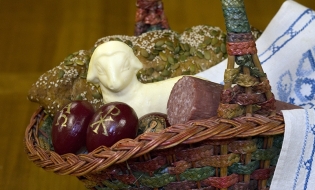Leftover hard-cooked eggs and a traditional potato salad

 This post first appeared in Northwest Catholic, the magazine for the Archdiocese of Seattle. The food basket was styled by Ellen Bollard of the office of communications for the archdiocese. Photo: Janis Olson/Archdiocese of Seattle
This post first appeared in Northwest Catholic, the magazine for the Archdiocese of Seattle. The food basket was styled by Ellen Bollard of the office of communications for the archdiocese. Photo: Janis Olson/Archdiocese of Seattle
As we enter Holy Week, we prepare to celebrate the central mystery of our faith: the death and resurrection of Jesus. But nearly everywhere I look, I see the commercial side of Easter.
Eggs are all over right now — chocolate, dyed and sugary versions that go in baskets with fake grass. The bunny trail also includes kids’ activities such as egg hunts and egg rolls.
But the egg has a profound association with Easter in the story of Jesus’ sacrifice and our redemption, and it can play a big role in teaching children about our faith. The egg has long been thought of as a symbol of the Resurrection. As the chick breaks forth from the shell, it is reminiscent of Jesus Christ leaving the tomb. And some say the rolling of eggs across the grass is symbolic of moving the stone from the front of the tomb.
In some cultures, eggs were colored bright red and decorated with Christian symbols such as the cross, Chi-Rho, Alpha and Omega, lily or fish. One legend says St. Mary Magdalene carried a basket of cooked eggs to share with the other women who were mourning at Jesus’ tomb. When she arrived to find the stone rolled away from the entrance and the tomb empty, the eggs in her basket turned bright red.
The faithful in Poland still prepare food baskets, including eggs, to be blessed at Mass. Closer to home, parishioners at St. Margaret of Scotland Parish in Seattle, which serves our Polish Catholic community, take baskets to the church on Holy Saturday for blessing, according to Father Andrzej Galant, pastor. Then “after coming back from the morning Easter celebration (‘Rezurekcja’), the family has an Easter breakfast. This begins with family prayer and a sharing of blessed eggs, which are symbols of a new life,” Father Galant wrote in an email.
Traditions along those lines are how Rudy Pojtinger of Kent and his first cousin Hildegard Janhunen of Aberdeen remember Easter.
According to Rudy, whose family roots date to 1776 in what’s now Ukraine, “Lenten fasting was brutal — no meat — but we made up for it at Easter. We dug in.” Rudy and his cousin Hildegard lived in a displaced persons camp in southern Germany after World War II before immigrating to the United States and eventually settling in Raymond with their extended family.
Hildegard remembers the baskets her mom and aunts prepared for Easter morning. They contained an eggy yeast bread, ham, special cheese, a ground beef and pork meatloaf dish, a lamb figurine made of butter and, of course, hard-cooked eggs that were colored naturally with boiled onion skins.
“The food was placed in a basket with a cloth underlining,” Hildegard said. “Then it would be covered with a special white cloth with stitchery, often in blue showing some kind of a scene — birds and trees, a boy and girl with a couple of birds.” She still has some of the cloths her relatives used so long ago.
In that spirit, I started thinking about days gone by and what to do with leftover hard-cooked eggs. I offer the Cleaveland family’s potato salad recipe — nothing exotic, but perfect to kick off what my grown kids call “potato salad season.” It goes nicely with that Easter ham.
Potato salad with cooked dressing

Photo: Rachel Bauer
– 10–12 hard-cooked eggs
– 8–10 Yukon gold potatoes
– 1 sweet onion (Walla Walla if available)
– salt and pepper
– paprika
Boil the potatoes with skins on until they are cooked, but not too soft. Allow to cool, then peel and dice them. You can use russets if you like.
Chop the onion and hard-cooked eggs. Add salt and pepper. Some in my family like celery as well. Put everything in a large bowl. Coat with the cooked dressing, using more or less according to your liking. Sprinkle with paprika and chill.
For the dressing:
– 1/2 cup sugar
– 1 teaspoon salt
– 1/2 teaspoon dry mustard
– 1 tablespoon flour
– 2 egg yolks
– 1 cup white vinegar
– 1/4 cup water
– mayonnaise
Combine the sugar, salt, mustard and flour in a bowl. In another bowl, beat the egg yolks and then add the vinegar and water. Put the ingredients in a double boiler. Stir until the mixture thickens and begins to bubble. Continue for another minute.
Remove from heat and add mayonnaise. Some people use 1 part cooked dressing to 1 part mayonnaise, but I try to cut back on mayo.
Food-safety note: If you are using eggs from an Easter egg hunt, make sure that they have not been out of the refrigerator for more than two hours. Also, examine them to make sure there are no cracks in the shells.
